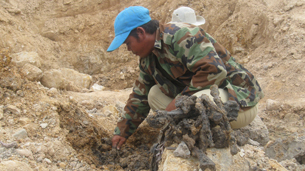Mass grave draws Cambodians
| Publisher | Radio Free Asia |
| Publication Date | 7 August 2012 |
| Cite as | Radio Free Asia, Mass grave draws Cambodians, 7 August 2012, available at: https://www.refworld.org/docid/5029151ac.html [accessed 30 May 2023] |
| Disclaimer | This is not a UNHCR publication. UNHCR is not responsible for, nor does it necessarily endorse, its content. Any views expressed are solely those of the author or publisher and do not necessarily reflect those of UNHCR, the United Nations or its Member States. |
2012-08-07
Recently uncovered remains are thought to be victims of Cambodia's Khmer Rouge regime.
 A member of a digging crew exhumes remains from a mass grave in Siem Reap province, Aug. 7, 2012. RFA
A member of a digging crew exhumes remains from a mass grave in Siem Reap province, Aug. 7, 2012. RFA
Cambodians who lost loved ones during the bloody era of the Khmer Rouge regime have been traveling from far and wide to pay their last respects at the site of a mass grave uncovered over the weekend in the country's northwest.
On Saturday, residents of Do Dontrei village in Siem Reap province's Kralanh district uncovered some 20 skulls and skeletons – some bound with rope – while they excavated land they intended to sell.
Experts believe there may be thousands of bodies buried in the area.
Crowds of visitors have since flocked to the site to hold Buddhist ceremonies honoring the dead and to try to determine whether their family members were among those who perished there.
Up to two million Cambodians died of disease, exhaustion, starvation, and execution under the ultra-Maoist Khmer Rouge rule from 1975-1979, which drove people out of towns and cities and abolished money, schools, and religion.
Kralanh district Governor Ean Khun said that based on the evidence uncovered, the remains of individuals found at the site were victims of the Khmer Rouge.
"They still have the cloth used to blindfold their faces," Ean Khun said.
"I listened to the villagers who live near the graves. They said the bodies were on top of each other stacked in twos or threes. The executioners used big stones to push the bodies down," he said.
"The last victims brought to die here were people from [nearby] Kampong Thkov commune. Their relatives came to retrieve their bodies in 1980."
Hong Sam Ol, one of the men who discovered the grave while preparing the land for sale, said that people had traveled from all over the country to inspect the remains.
"Many people from near and far came here to look for their loved ones. They brought with them incense and fruit to offer the dead," he said.
"Some came back and forth several times to light incense while looking for their parents and siblings. Many left frustrated."
 Human remains are gathered for a Buddhist ceremony at a mass grave site in Siem Reap province, Aug. 7, 2012. Credit: RFA
Human remains are gathered for a Buddhist ceremony at a mass grave site in Siem Reap province, Aug. 7, 2012. Credit: RFA
'Several' mass graves
Even those who knew the final resting place of their loved ones, like Lem Sok Le who lost six members of her family elsewhere in Cambodia during the Khmer Rouge era, traveled to the site to pay their respect to the dead.
"I lit incense and dedicated it to the dead so that their spirits could peacefully leave for the new world," she said.
"So many people were brought to die here, almost everywhere around this mountain. I lost [several] family members and my brother-in-law lost his whole family during the Pol Pot regime," she said, referring to the former head of the Khmer Rouge.
The Khmer Rouge regime established some 200 prisons where inmates were tortured before being killed.
The Associated Press quoted the director of the Documentation Center of Cambodia, Youk Chhang, as saying that the area around the site in Do Dontrei village had been identified as having several mass graves based on interviews with hundreds of villagers, though it was never excavated.
Youk Chhang, whose organization collects evidence about Khmer Rouge atrocities, said that an estimated 35,000 people died at this prison, which was located between Do Dontrei and Kampong Thkov.
Historians and researchers say there could be thousands of bodies buried in the area, about 60 kilometers (40 miles) from Siem Reap, the site of Cambodia's famed Angkor temples.
Digging crews plan to continue excavating the area following a formal Buddhist ceremony planned for later this week.
Reported by Hang Savyouth for RFA's Khmer service. Translated by Sum Sok Ry. Written in English by Joshua Lipes.
Link to original story on RFA website
